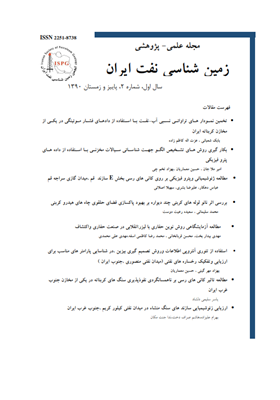استفاده از تئوری انتروپی اطلاعات وروش تصمیم گیری بیزین ،در شناسایی پارامتر های مناسب برای ارزیابی وتفکیک رخساره های نفتی (میدان نفتی منصوری ،جنوب ایران )
محورهای موضوعی :
1 - دانشگاه تهران
کلید واژه: روش های احتمالی تئوری انتروپی اطلاعات روش بیزین رخساره های نفتی امپدانس کشسانی میدان نفتی منصوری وایران ,
چکیده مقاله :
به دلیل ناهمگنی زیر زمین از یک طرف وابهامات موجود در تفسیر ژئو فیزیکی از طرف دیگر ،همواره شناسایی وتفسیر رخساره های درون چاهی با عدم قطعیت وریسک همراه است .امروزه روش های متنوعی جهت تفسیر کمی رخساره های نفتی گسترش یافته است که بطور کلی به دو دسته تعیینی واحتمالی تقسیم می شود .روش های تعیینی بر خلاف سادگی فرایند مدل سازی ،قادر به ارائه خطا یا میزان صحت مدل به دست آمده نیستند .روش های احتمالی ،علاوه بر کمی کردن خطای مدل ،احتمال صحت آن را نیز در جای جای مخزن،بدست می دهند .روش بیزین از جمله روش های احتمالی می باشد که از احتمالات شرطی جهت مدلسازی استفاده می کند .این روش فعلاوه بر مدلسازی احتمالی رخساره های نفتی ،اثر اطلاعات افزودنی در کاهش خطای دسته بندی را به صورت کمی ارائه می کند. تئوری انتروپی اطلاعات با کمی کردن عدم قطعیت ذاتی هریک از پارامتر های ورودی برای مدلسازی ،انتخاب پارامتر های با ارزش را به سادگی امکان پذیر می سازد .در این مطالعه،که بر روی یک چاه از میدان نفتی منصوری واقع در جنوب ایران صورت گرفته است ،پس از تولید داده های آموزشی با روش فیزیک سنگ و به کمک رابطه گاسمن ،ابتدا با تحلیل انتروپی ارزش هریک از پارامتر های ورودی مشخص شد .سپس با استفاده ازتحلیل بیزین وبه کمک پارامتر های موثر جداسازی وتفکیک رخساره های نفتی ،انجام شد .پنج پارامتر بهینه ،پارامتر های امپدانس کشسانی ،سرعت موج فشاری ،سرعت موج برشی ،چگالی وتخلخل بود که میزان خطای دسته بندی با استفاده از این پارامتر های با ارزش در حدود 11در صد بدست آمد وهم چنین بررسی نشان داد که پارامتر پرتو زائی گاما تاثیر مثبتی در روند شناسائی وتفکیک رخساره ها نداشته ،که با نتایج حاصل از انتروپی مطابق می باشد .
Due to subsurface heterogeneity and existing vagueness in geophysical interpretation, identifying and interpretation of facies in wellbores is always prone to uncertainty and risk. Nowadays several methods have developed for quantitative facies interpretation. These methods are generally divided into deterministic and stochastic categories. Deterministic methods, in spite of their simple modeling procedure, cannot expose the amount of error or accuracy of the model. On the other hand, stochastic methods, in addition to quantifying the error of the model, can provide the probability of the model’s accuracy in each point of the reservoir. The Bayesian approach is one of the stochastic methods that use conditional probabilities for modeling. This approach, as well as probabilistic modeling of hydrocarbon facies, quantitatively computes the effect of additional data in decreasing the error of the classification. Information entropy theory, by quantifying the intrinsic uncertainty in each model input parameter, can easily provide the selection of valuable parameters. The present study was carried out on one of the wells of Mansuri oil field, south of Iran. After generation of training data by using rock physics techniques and Gassmann’s relation, the value of each input parameter was identified by entropy analysis. Then, by use of Bayesian analysis and valuable parameters, oil facies classification and discrimination was implemented. The five optimum parameters were elastic impedance, compressional wave velocity, shear wave velocity, density and porosity .The amount of error in this method is approximated to be 11 percent. This investigation also showed that gamma ray parameter does not have a drastic positive effect on identification and discrimination procedure of oil facies, which has a good agreement with the results of entropy analysis .


